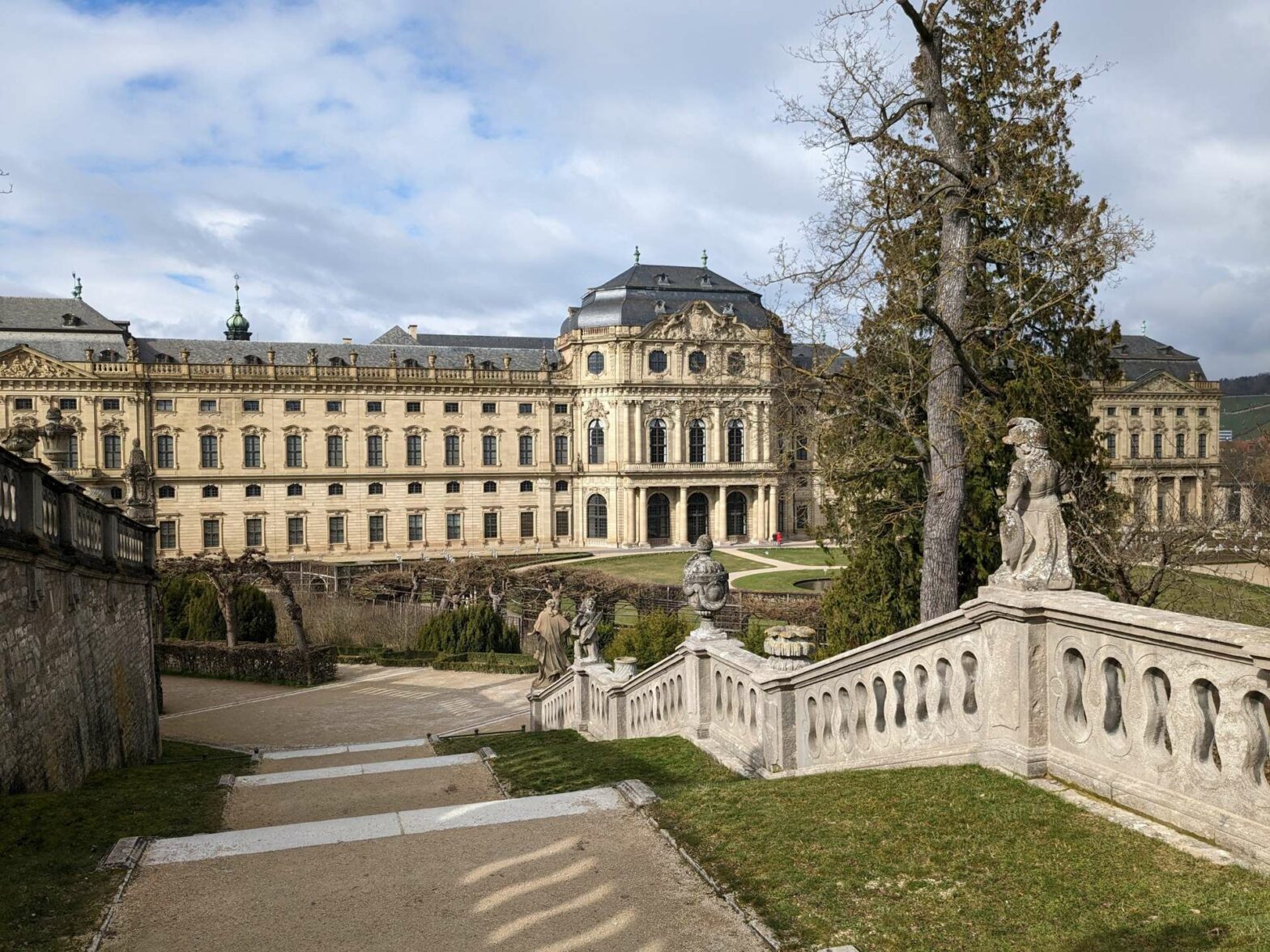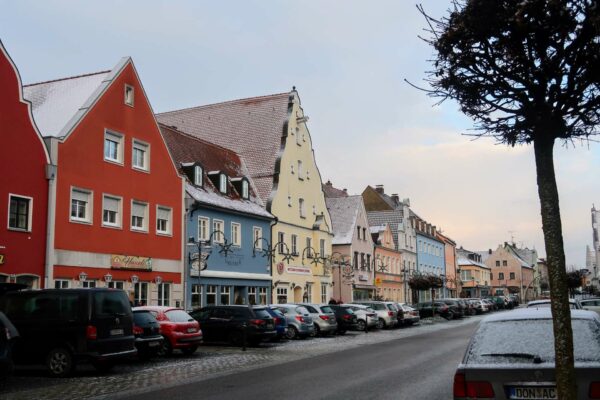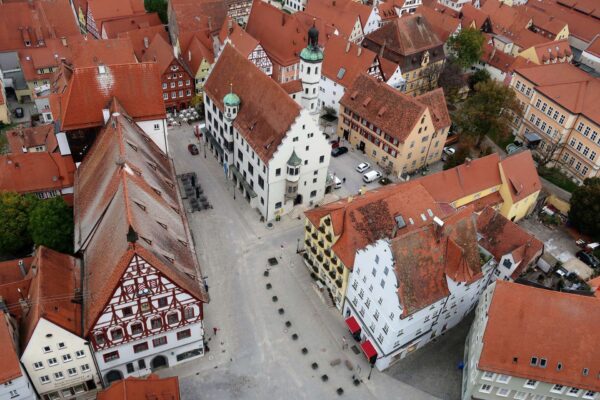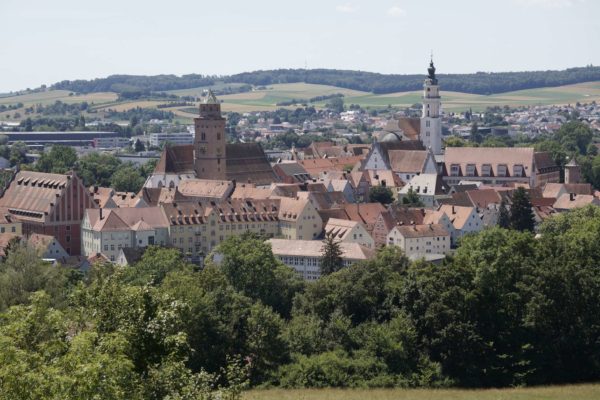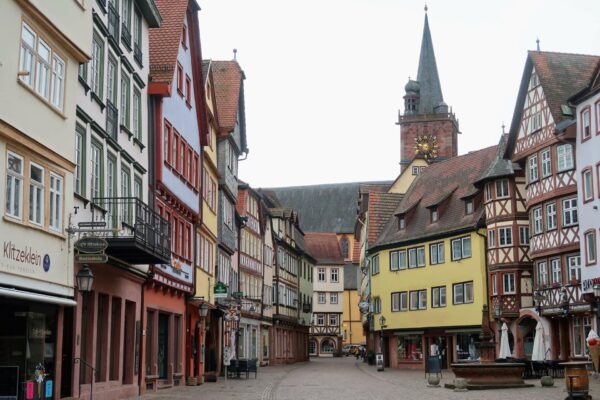By Vicky · Published Mar. 3rd, 2023 · Updated Mar. 23rd, 2023
When you buy through links highlighted with an asterisk (*) on this site, we may earn a small affiliate commission at no cost to you.
Würzburg, a charming city in Bavaria, Germany, is known for its baroque architecture, excellent wine, and rich cultural heritage. One of the best ways to explore this fascinating city is through a walking tour, which allows you to discover its hidden gems and immerse yourself in its history and culture.
Page Contents:
Location
This walk starts from Market Square in the centre of Würzburg Altstadt. It’s about 1km, or 12 minutes walk southwest of Würzburg Hauptbahnhof. On the train, Würzburg is just over an hour from Frankfurt and just over two hours from either Stuttgart or Munich.
Würzburg Walking Tour Map
Get the route by downloading the .gpx or .kml file below. For navigation with Maps.me on your mobile phone, simply download the .kml file and open to add it to the Maps.me bookmarks.
Tips for Würzburg Walking Tour
- Plan your day in Würzburg around the timings of English tours of the Residence (11am & 3pm year-round, extra tours at 1:30pm and 4:30pm Apr-Oct.) and Marienberg Fortress (Apr-Oct 3pm on weekends).
- Würzburg is at the northern end of the Romantic Road, a famous tourist route through Bavaria ending at Neuschwanstein Castle.
- Check out other walks on our Germany Hiking Page.
Top Sights in Würzburg
On this self-guided walking tour you’ll visit the most famous landmarks and attractions in Würzburg. One day is the perfect amount of time to spend in Würzburg, though you could use the town as a base to explore other nearby towns near the top of the Romantic Road.
- Altstadt & Market Square
- New Munster
- St. Kilian Cathedral
- Würzburg Residence
- Juliusspital
- Old Town Hall
- Old Main Bridge
- Marienberg Fortress
Würzburg Walking Tour Route
This walking tour starts at Market Square, which is the heart of the city and the perfect starting point to explore Würzburg.
1. Altstadt & Market Square
No walking tour of Würzburg would be complete without a visit to its charming Altstadt, or Old Town. This area is home to a variety of shops, cafes, and restaurants, along with several historic buildings and landmarks.
The Market Square is surrounded by beautiful historic buildings and is home to the Gothic Marienkapelle, a striking red and white church dating back to the 14th century. Just behind the chapel is the Haus zum Falken, or Falkenhaus, a beautifully restored 18th-century building. Today the city’s tourist information centre is inside.
Directions: Leave Market Square behind the chapel and past Haus zum Falken. At the main street turn right. You’ll see the New Munster soon on the left, walk up the steps to head inside.
2. New Munster
The New Munster, or Neumünster (open 6am-6:30pm Mon-Sat, from 8am Sun), is in the heart of the Altstadt. It’s a Romanesque church that was built in the 11th century and is one of the oldest churches in Würzburg.
It was here that three Irish missionaries tried to convert the local Duke Gosbert to Christianity and died for it. Today you can see statues of the three missionaries around the church. The most famous of the three is St. Kilian, now patron Saint of Würzburg. You can visit his tomb in the crypt, a place said to vibrate with positive energy and many pilgrims come here to be healed.
Directions: Continue along the street and you’ll see the cathedral on your left.
3. St. Kilian Cathedral
Key Information: Open Mon-Sat 10am-5pm, Sundays 1-6pm, free entry. Museum open Tue-Sun 12-5pm, tickets €5/4.
St. Kilian Cathedral, or Würzburg Cathedral (Website, TripAdvisor reviews*) is a beautiful baroque cathedral. It dates back to the 11th century but was burnt out in 1945 and later fully restored. The outside remains true to its original form, while the inside is a blend of modern and old and surprisingly beautiful. Interestingly, there’s a large menorah at the entrance to the church celebrating Christianity’s roots in Judaism.
The Museum am Dom (Website, TripAdvisor reviews*) is in the courtyard to the left and behind the cathedral. It’s surprisingly interesting and showcases religious objects, paintings, gold and more. Similar to inside the cathedral itself, there are both old and modern pieces, displayed contrastingly next to each other on various themes.
Directions: Head into the courtyard to the left of the cathedral where the Museum is. At the road on the other side, turn right. Follow this road and it will lead you all the way to the grand Residence.
4. Würzburg Residence
Key Information: Open Apr-Oct 9am-6pm, Nov-Mar 10am-4:30pm. Visits by guided tour only. Tours in English at 11am & 3pm year-round, extra tours at 1:30pm and 4:30pm Apr-Oct. Tickets are €9/8. Martin von Wagner Museum – free entry, closed Sundays.
The Würzburg Residence (Website, TripAdvisor Reviews*) is one of the finest renaissance/baroque buildings in Germany and one of the city’s most iconic landmarks. This magnificent palace was built in the 18th century and is known for its stunning baroque architecture, ornate gardens, and impressive art collection. The palace’s opulent interior is filled with stunning frescoes, intricate stucco work, and exquisite furnishings.
You can explore the Residence by yourself (information in English and German in every room), or take a tour to be guided around a few of the most impressive rooms. The Martin von Wagner Museum is in one wing of the Würzburg Residence. It’s home to a large art collection, with antiquities, sculptures and a few important paintings. It’s free so you may as well at least walk through.
Don’t forget to visit the Hofgarten (free entry) either before or after looking around the palace. It’s a French-style garden designed in the 18th century and is a very pleasant place to take a stroll, with a central large lake and Rococo sculptures. To get to the entrance of the garden, head left when leaving the Residence to the gate in the corner.
Directions: Once you’ve finished looking around the gardens, leave the area on the road you came in on. Instead of continuing straight, take the first right on Maxstraße. Follow the road as it bends left by a small park. Walk onwards into the pedestrianised area. Turn right when you reach the street with the tram lines and the Juliusspital is the grand building at the end of the street.
5. Juliusspital
The Juliusspital is a historic hospital and winery (Weingut Juliusspital) that dates back to the 16th century. The estate is known for its excellent wine and is a popular spot for visitors to sample the local wines and learn about the wine-making process. It’s a nice building with beautiful gardens, and you can wander around freely.
There are wine-tasting tours (Website) where you can explore the wine cellars, which all finish with a tasting, or just visit the wine shop to buy any of the reasonably priced wines. Würzburg is still renowned for its wine today, and the city is surrounded by vineyards.
Detours:
If you’re interested, visit the Röntgen Memorial Site just north of the Juliusspital. To explore more of the vineyards, head even further north to the slopes north of the train station.
Röntgen Memorial Site
The Röntgen Memorial Site, or Röntgen-Gedächtnisstätte (open 8am-2pm weekdays, free entry) commemorates the site of one of the most important scientific breakthroughs in medical history. Here in 1895, Prof. Dr. Wilhelm Conrad Röntgen discovered a new kind of ray, which he called X-rays. It’s an interesting and informative little museum, with explanations in both English and German about physics in the late 19th century.
Walk in the Vineyards
The walk from south of the station around the vineyards and back is roughly 5 km with about 100 metres of climb. There are great views over the vines and city below, and you can also taste some of the wine in the wineries dotted around the slopes.
Directions: Leave the Juliusspital and walk right along the main road. Walk around the building at the far end to reach the river bank and turn left.
Walking by the riverside, you’ll first come to the Old Cranes, or Alter Kranen, dating from 1773. Not much further along the river, you’ll come to a great viewpoint of the Old Main Bridge with the Marienberg Fortress up above on the other side.
Directions: When the riverside path ends, continue along the road and take the first left. You’ll then be in a pedestrianised square with the town hall complex on your left.
6. Würzburg Old Town Hall
The Old Town Hall is a rather lovely building, the oldest part of which is called the Grafeneckart from the 13th century. At the base of the building, you can enter a little room containing a display about the bombing of Würzburg during WWII. There’s a model of the town immediately after the destruction, and a description (English and German) of the town’s experience during the war.
Directions: Head onto the bridge.
7. Old Main Bridge
The Old Main Bridge, or Alte Mainbrücke, is a historic bridge that spans the River Main and offers stunning views of the city. The bridge is lined with statues of saints and historical figures and is a popular spot for locals and tourists alike to relax and enjoy the views. On sunny days, the bridge will be full of people sampling the local wine.
Directions: Cross the bridge, head over the first road and turn left on the smaller road. When this road begins to bend, turn right by the church, following the signposts to Marienberg Fortress. Follow the track as it meanders up the hill and around the corner to the back of the Fortress. Eventually, you’ll head inside the walls and make your way inside the castle itself.
8. Marienberg Fortress
Key Information: Castle open Apr-Oct 9am-6pm, Nov-Mar 10am-4.30pm, closed Mondays, free entry. Tours cost €4/3, in German only (sometimes English tours 3pm Apt-Oct). Museum für Franken open 10am-16/17pm in Apr-Oct/Nov-Mar, closed Mondays, tickets €5/4.
The Marienberg Fortress (Website, Tripadvisor Reviews*), or Festung Marienberg, is one of the top sights in Würzburg. This medieval fortress overlooks the city and offers panoramic views of the surrounding countryside. It dates back to the 13th century and served the powerful Prince-Bishops of Würzburg until they moved into the Residence which they had designed.
Today the fortress is home to a museum, a chapel, and several gardens. You can walk around the gardens and inner courtyards of the castle for free. If you go on a fun and informative guided tour (German only) you get to visit a few extra areas, such as Saint Mary’s Church, the well and a stone corridor leading to the Princes’ Garden.
Museum für Franken
The Museum für Franken (Website) is also housed in the castle, showcasing the history and artwork of Franconia (the northern part of Bavaria). A highlight of the museum is the large collection of carvings by Tilman Riemenschneider, a famous wood and stone worker. There are also some nice models of the town showing its development and subsequent destruction in the WWII bombings.
Directions: The castle is the last stop on the Würzburg Walking Tour. To head back to the centre of town, leave the castle via the gardens and head through the door down the steps into the park. If this door is closed, you’ll have to walk back around the way you came and leave along the paved road into the park. Walk down through the park and head right at the bottom to cross back over the Old Main Bridge into town.
Other towns on the Romantic Road include walled Nördlingen, pretty Donauwörth and stately Augsburg, or head east to Bamberg and historic Nuremberg. For more walking tours and hikes in Germany, see our Germany hiking page.

